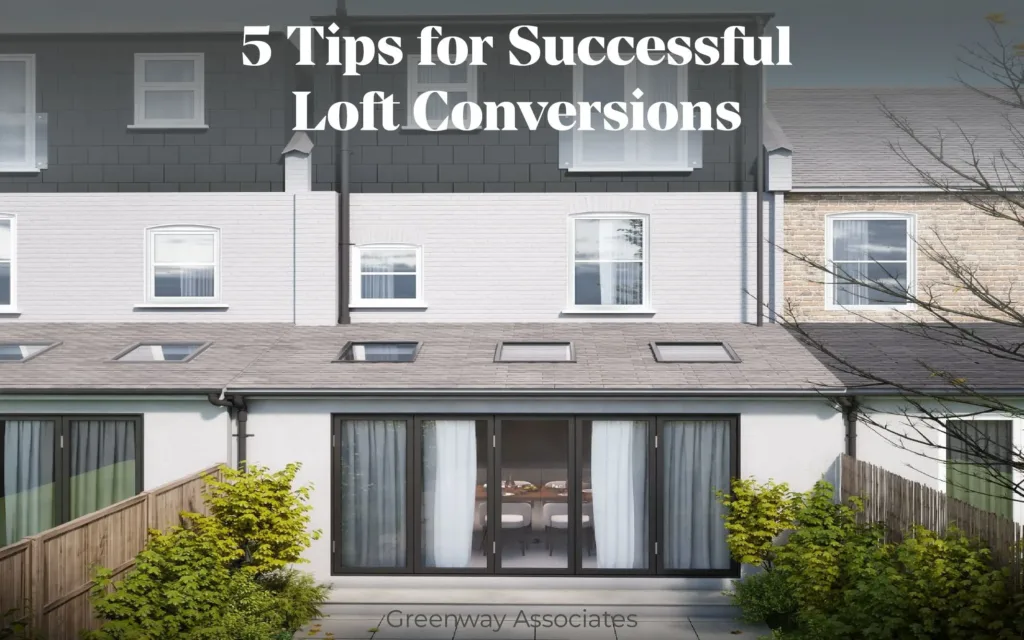5 Top Tips for Successful Loft Conversion: Transform Your Space
Imagine waking up to a stunning view from your brand-new bedroom, a space that was once a dusty old loft. Loft conversions are not just a trend; they’re a smart, cost-effective way to add both space and value to your home. Want to know our top tips for loft conversion?
A loft conversion can increase your home’s value by up to 20% Whether you’re looking for extra living space, a home office, or an additional bedroom, a loft conversion can transform your home into a masterpiece. Here are our 5 tips for loft conversion that can increase the value of your property in London.

5 tips for Loft Conversion
Table of Contents
- Understanding Loft Conversions
- Planning Your Loft Conversion
- Top Tips for Loft Conversion
- Conclusion
Understanding Loft Conversions
A loft conversion involves transforming an unused attic space into a functional room. Common types include:
8 Types of Loft Conversions
- Dormer Loft Conversion: Adds headroom and usable space.
- Hip to Gable Loft Conversion: Ideal for semi-detached homes.
- Mansard Loft Conversion: Maximises space with a flat roof and vertical walls.
- Velux Loft Conversion: Utilises skylights to enhance natural light.
- L-shaped loft Conversion: Creates a significant amount of space for larger properties.
- Pitched Dormer Conversion: Brings an extraordinary amount of character due to all the angles it creates internally.
- Side Dormer Conversion: A side dormer conversion can turn a small dark loft into an amazing bright, open space.
- Piggyback Conversion: It removes all of the existing roof and raises the perimeter walls by approximately 1.3m. You get significant head height.
Planning Your Loft Conversion
Before diving into the construction, thorough planning is crucial. Start by assessing your loft’s suitability. Ensure there’s enough headroom, space, and structural integrity. Consult with professionals to understand the costs, which can range significantly based on the type of conversion and your location in the UK.
5 Top Tips for Successful Loft Conversions
While there are many things you can do with your loft conversions, here are our 5 top tips for loft conversion.
1. Check Building Regulations and Planning Permissions
Loft conversions in the UK usually fall under permitted development, meaning you might not need planning permission. However, if you’re making significant changes to your home’s exterior, it’s essential to check local regulations. Always ensure your plans comply with building regulations to avoid legal complications.
2. Maximize Space and Light
One of the key attractions of a loft conversion is the additional light it brings into your home. Consider installing skylights or a floor-to-ceiling window. Dormer windows can add headroom and usable space, while Velux windows are great for enhancing natural light. Plan your layout to make the most of the available space, turning awkward angles into creative storage solutions.
3. Choose the Right Type of Loft Conversion
Selecting the appropriate type of loft conversion is critical. Here are a few options:
- Dormer Loft Conversion: Adds headroom and usable space.
- Hip to Gable Loft Conversion: Ideal for semi-detached homes.
- Mansard Loft Conversion: Maximizes space with a flat roof and vertical walls.
- Velux Loft Conversion: Utilizes skylights to enhance natural light.
Each type has its pros and cons, so discuss these with your architect to find the best fit for your home.
4. Hire Professionals
While DIY projects can be tempting, loft conversions are complex and require professional expertise. Hire experienced architects, builders, and electricians to ensure the work meets high standards and complies with regulations. Professional input can save you time, money, and stress in the long run.
5. Incorporate Clever Storage Solutions
Loft spaces often come with challenging angles and limited headroom. Use these to your advantage by incorporating built-in storage solutions. Eaves storage, bespoke wardrobes, and shelving can maximize space and keep your new room clutter-free.
Conclusion
A loft conversion is an excellent way to enhance your living space and increase the value of your home. By carefully planning and considering the tips above, you can create a beautiful, functional new area that meets your needs. Remember, the key to a successful loft conversion lies in understanding your space, choosing the right type of conversion, and hiring the right professionals. If you liked our tips for loft conversion, follow us on Instagram @greenwayassociates.



